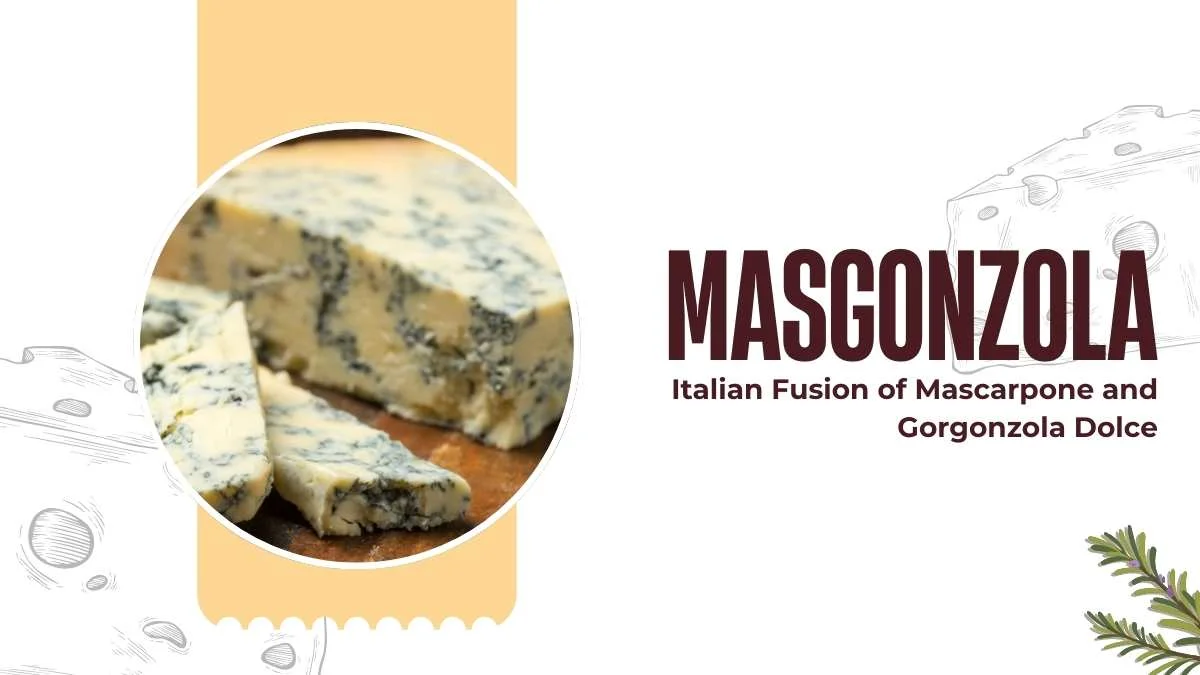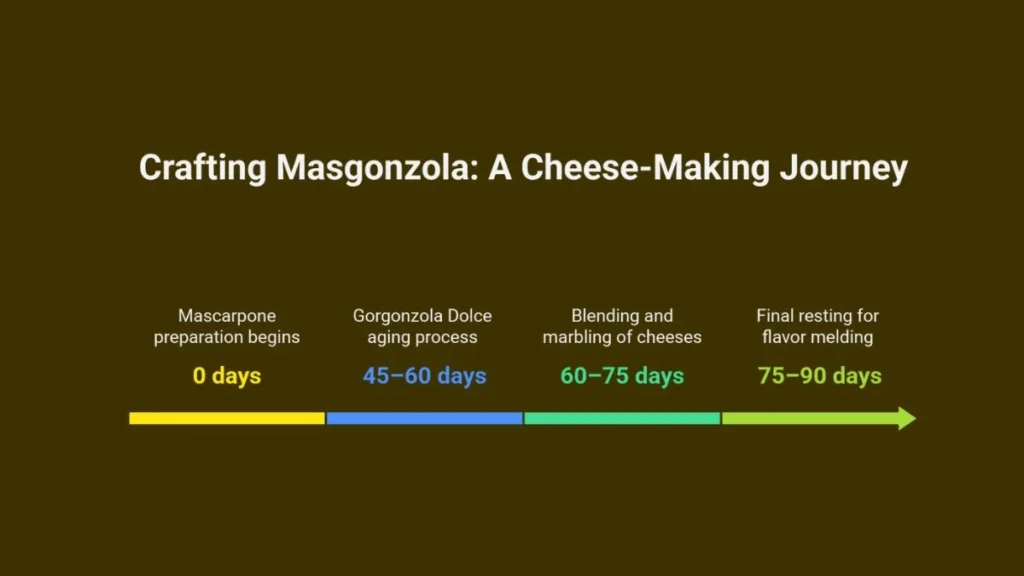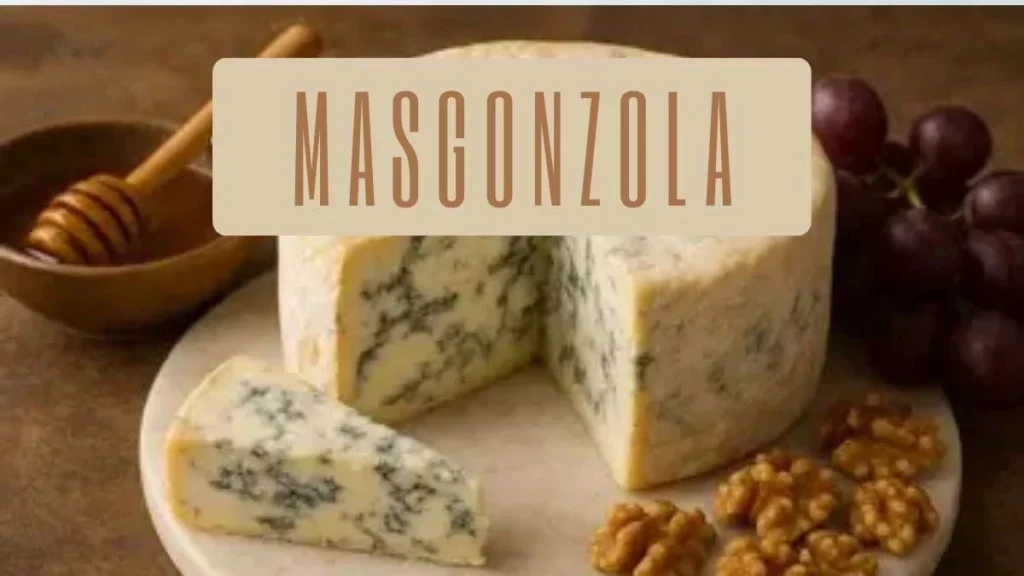FOOD AND DRINKS
Masgonzola: Italian Fusion of Mascarpone and Gorgonzola Dolce

Masgonzola is a luxurious Italian cheese born from the marriage of two culinary icons: the velvety smoothness of mascarpone and the gentle tang of Gorgonzola Dolce. Originating in Northern Italy, it offers a distinctive experience, creamy and sweet from mascarpone, subtly sharp from the delicate blue veins of Gorgonzola. With its soft, marbled texture and balanced flavor profile, Masgonzola stands as a gourmet indulgence suited for both casual enjoyment and refined dining.
Hailing from Northern Italy, this marbled delicacy is as versatile as it is exquisite, equally at home on a rustic breadboard or in refined restaurant dishes. Whether paired with honey and figs or swirled into risotto, Masgonzola transforms even the simplest meal into a gourmet experience.
Table of Contents
Northern Italian Roots and Inspiration
Masgonzola’s origins lie in the dairy-rich Lombardy and Piedmont regions. Lombardy is the birthplace of mascarpone, known for its velvety texture and buttery sweetness. Just to the west, the town of Gorgonzola produces the mild, creamy, and delicately tangy Gorgonzola Dolce.
The combination of these two cheeses marries mascarpone’s silken richness with the subtle sharpness of blue-veined Gorgonzola Dolce. The result is indulgent yet balanced, an innovation that honors tradition while offering something entirely new.
Appearance and Texture Appeal
Visually, Masgonzola is captivating. Its pale mascarpone base is marbled with delicate blue-green veins of Gorgonzola Dolce, forming intricate streaks created by Penicillium roqueforti. This artistic patterning makes it a showpiece on any cheeseboard. Its soft, supple texture is effortlessly spreadable, melting smoothly on the tongue while delivering layers of flavor.
The Craft Behind the Cheese
Producing Masgonzola requires artisanal skill and scientific precision.
- Mascarpone preparation is made by gently heating heavy cream, adding citric or tartaric acid to coagulate, then draining the curds for the perfect consistency.
- Gorgonzola Dolce production. Created from whole cow’s milk, inoculated with Penicillium roqueforti, and aged for 45–60 days. Piercing with steel needles allows oxygen in, encouraging the mold to form its signature veining.
- Blending and marbling. Once matured, the two cheeses are combined in carefully measured proportions. Mascarpone softens and sweetens the Gorgonzola, while the blue cheese lends depth.
- Final resting. The mixture is folded gently to maintain its marbled effect and allowed a short maturation period for flavors to meld.

Creative Serving Ideas and Food Pairings
Masgonzola’s adaptability makes it a favorite among home cooks and professional chefs alike.
Cheese Boards and Starters
Spread generously on warm bread or toasted brioche. Pair with honey, fig jam, or quince paste to enhance its sweet notes, and add toasted walnuts, almonds, or hazelnuts for texture.
Pasta and Risotto
Melt Masgonzola into creamy risotto for richness or toss with freshly cooked pasta, cracked black pepper, and a drizzle of extra virgin olive oil for an elegant, simple dish.
Meat and Vegetables
Use as a stuffing for chicken breasts or pork tenderloin, locking in moisture while adding depth. Melt into sauces for roasted vegetables like asparagus or zucchini to elevate a simple side.
Desserts
Blend into a mascarpone cheesecake for a subtle blue-cheese twist, or layer between honey sponge cake for a sweet-savory interplay.
Nutritional Profile and Benefits
| Nutrient | Amount per 100g | Benefit |
| Calories | ~350 kcal | Provides energy for daily activities |
| Protein | 10–12 g | Supports muscle growth and repair |
| Fat | 30–32 g | Source of essential fatty acids and flavor |
| Saturated Fat | ~20 g | Adds creaminess, but should be consumed in moderation |
| Carbohydrates | 2–3 g | Minimal carb content, good for low-carb diets |
| Calcium | 500–550 mg | Strengthens bones and teeth |
| Sodium | 900–1000 mg | Enhances flavor, but should be limited for heart health |
Cultural Relevance in Italy and Beyond
Masgonzola is more than a culinary fusion; it reflects the Italian spirit of convivialità, the joy of sharing good food. It has found a place not only in Italian homes but also on the menus of fine dining establishments and in gourmet food markets worldwide. Its appeal lies in its ability to bridge the gap between tradition and contemporary tastes.

Storage and Handling Guidelines
To keep Masgonzola at peak quality:
- Store at 4–6°C (39–43°F) in wax paper or cheese paper to allow breathing while preventing drying.
- Consume within one week of opening for optimal flavor and texture.
- Bring to room temperature before serving to release its full aroma and creaminess.
FAQs
Q1: Is Masgonzola suitable for beginners to blue cheese?
Yes. The mascarpone base mellows the blue cheese tang, making it approachable.
Q2: Can Masgonzola be frozen?
Not recommended, as freezing alters its creamy texture and nuanced flavor.
Q3: How does Masgonzola differ from standard Gorgonzola?
It blends mascarpone with Gorgonzola Dolce, resulting in a sweeter, creamier, and more spreadable cheese.
Conclusion
Masgonzola stands as a shining example of Italian cheesemaking ingenuity, a harmonious marriage of two beloved dairy icons. With its creamy sweetness, gentle tang, and striking marbling, it is as much a visual delight as it is a culinary treasure.
Whether drizzled with honey, folded into pasta, or served alongside fine wine, Masgonzola offers a sensory journey that celebrates the art of balance. In every bite, it proves that the most memorable flavors often come from perfect unions.
-

 FRIENDSHIP MESSAGES4 weeks ago
FRIENDSHIP MESSAGES4 weeks ago100+ Heart Touching Sorry Messages for Friends
-

 ANNIVERSARY WISHES5 months ago
ANNIVERSARY WISHES5 months ago100+ Beautiful Engagement Anniversary Wishes Messages and Quotes
-

 BIRTHDAY WISHES4 months ago
BIRTHDAY WISHES4 months ago300+ Happy Birthday Wishes for Brother | Heart Touching Happy Birthday Brother
-

 BIRTHDAY WISHES5 months ago
BIRTHDAY WISHES5 months ago200+ Unique Birthday Wishes for Your Best Friend to Impress on Their Big Day




































